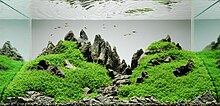Natural aquarium
As a natural aquarium , also called Japanese natural aquarium or Japanese aquarium , the freshwater aquariums are referred to, in which aquarium plants play at least an equal role to the fish species kept in the aquarium . Despite the somewhat misleading name, it is not a biotope aquarium . This branch of aquaristics was significantly shaped by the Japanese photographer and aquarist Takashi Amano , who developed a special plant aquarium using the design principles of Japanese culture , especially Zen . The aim of the aquarist practicing such a nature aquarium hobby is to create landscape-like spaces (through “ aquascaping ”) using decorative materials suitable for aquariums such as bog roots and stones as well as mostly a few plant species .
Typical for the planting of a natural aquarium is an extensive and dense planting of the foreground with small aquarium plants. This gives the aquarium a certain optical depth. The free space in the aquarium is a central design element and is strongly emphasized. The golden ratio is also used . Amano generally used very soft, low-carbon water. The side walls and rear panes are almost always free of decoration. A black or deep blue foil is often glued to the back of the aquarium.
In the Dutch planted aquarium, on the other hand, many different plants are used in the aquarium in a manner comparable to a garden bed (Amano called it "flower bed aquaristics"), whereby here too (in contrast to the "German aquarium", which shows a livelier mess of plants) special design rules are used come. A natural aquarium, on the other hand, can consist, for example, of a “meadow” of grass-like sword plants or short Java moss from which a wooden root protrudes like a tree. Other typical plants in the Japanese natural aquarium are tongue leaf , pond liver moss and needle ledge .
Both types of aquariums, whose design principles can also be found in combination, are often dependent on carbon dioxide fertilization because of the major role that aquarium plants play in this .
literature
- Hans-Georg Kramer: Plant aquaristics á la Kramer. Tetra-Verlag, Berlin-Velten 2009, ISBN 978-3-89745-190-2 , pp. 97-105.
